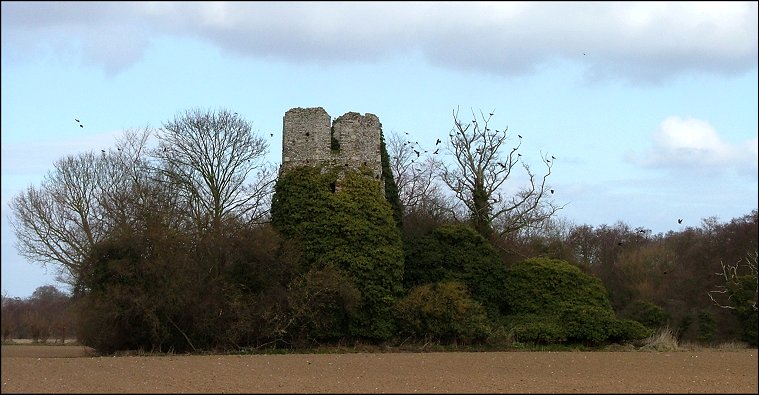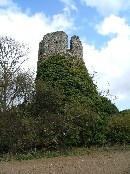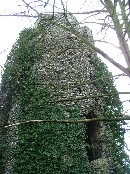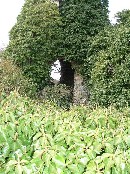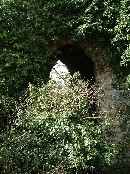| |
|
St Mary,
Burgh St Mary In the middle of a wide, ploughed field just
to the west of Caister, this magnificent ruin stands,
like a castle adrift on a brown sea, a city of the plain.
Chris parked on the edge of the field, and we were still
a good quarter of a mile from it. Not unreasonably,
having been here before, he waited in the car while I set
off for the ruin.
As far
beyond it, a line of wintry trees seemed another country.
Beneath my feet the soil was sand-like, powdery, quite
unlike my recent experiences of getting bogged down in
the mud of central Norfolk. Here, it felt as if a sudden
gust might lift the soil and leave me walking through a
cloud.
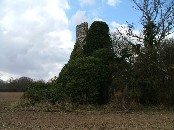 |
|
There
is a public footpath to the ruin marked on the
Ordnance Survey map; but, with the recent shallow
ploughing of the field, all trace of it had
disappeared, and so I had to try and follow its
course in my imagination. I loved this.
It was like walking across virgin snow, my
footprints the only jarring in this vast expanse
of curving, parallel lines. Occasionally,
I looked back at the road, which receded into
silence as I moved further from it. Ahead, the
tower was more like a fortress than a church. I
tried to imagine what it would be like if I was
an invader, if there were forces there to try and
keep me out.
|
| Burgh
St Mary is not to be confused with Burgh-next-Aylsham and Burgh Parva, both of
which have churches dedicated to St Mary. The
parish here is adjacent to Burgh St Margaret, and
after the Reformation this was the church which
fell into disuse. Ironically, St Margaret was
almost completely rebuilt in the 1870s, and so
more of the medieval St Mary survives than of St
Margaret. As I got closer, the nervous
jackdaws noticed my presence, and it spooked
them. They rose from the tower in a worried
flurry, seeking the higher ground of the adjacent
treetops, from which they watched me warily. The
remains of the round tower top are octagonal, a
bell stage. Because of this, the tower appears
square from the road. I got to the island of
trees, and parted the brambles to climb inside.
The wind had dropped completely, and there was a
deep silence, apart from the occasional squawk of
a distant jackdaw and a persistent rustling on
the far side of the tower.
|
|
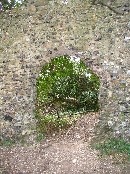 |
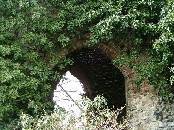 |
|
Except
for the bell stage, which is probably 13th
century, the round tower was early Norman, and
archaeological investigations of the site suggest
a similar date for the rest, at least what
survives, which isn't much. The north wall is
good up to a certain level, and you can still see
where the north doorway was. As I walked
around to the north side I could see that my
rustling companion was a plump pheasant, which
put its head down and ran for the chancel, or at
least where the chancel used to be, before
breaking through the cover and erupting like a
helicopter into the field. As he disappeared, the
copse lay still again. I
walked into the nave. I noticed that the tower
arch was made of brick, so perhaps there was some
work going on here in late medieval times.
|
| I stepped through to the
space beneath the tower, and looked up. The
circular interior tapered slightly, like a
chimney, and a wooden beam was wedged between the
inner splays of the windows. Someone had tied a
rope to this, but it didn't look secure, and so I
didn't climb up. Instead,
I lifted my camera to take the photograph you see
on the right. The flash filled the funnel with
light for an instant, and in the next second a
huge white shape, a ghost, fled from one of the
window splays and fell towards me. It opened two
white arms; for a moment, its round face looked
into mine. And then it stalled furiously, and
threw itself up the chimney again, exploding out
of the mouth of the tower.
|
|
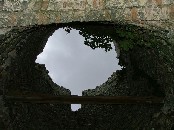 |
It was a barn owl, the
colour of snow. I stumbled clumsily back out through the
north doorway, to the edge of the copse, in time to watch
it receding, wings pumping lazily, powerfully, effortless
in its straight, dipping course, drifting across the wide
field to the woods beyond.
Simon Knott, March 2006
|
|
|

